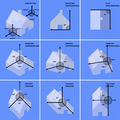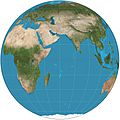Orthographic projection facts for kids
Orthographic projection is a special way to draw 3D objects on a flat, 2D surface, like a piece of paper or a computer screen. Imagine looking at an object straight on, without any part of it looking further away or smaller. This method helps show the true size and shape of an object from different angles. It's like looking at a building from the front, then from the side, and then from above, all without any distortion.
Contents
What is Orthographic Projection?
Orthographic projection is a type of "parallel projection." This means that all the lines used to project the object onto the flat surface are parallel to each other. They don't come together at a single point, like they do in perspective drawings. Think of it like the sun's rays hitting the Earth; they are so far away that they seem parallel.
This method is very useful because it shows the exact measurements of an object. When you draw something in orthographic projection, a 10-foot long wall will always be drawn to scale as 10 feet long, no matter where it is on the drawing. This is different from how our eyes see things, where objects further away look smaller.
How Does It Work?
To create an orthographic projection, you imagine looking at an object from a specific direction. Then, you draw what you see directly onto a flat surface. The lines from the object to the surface are always at a 90-degree angle (perpendicular) to that surface.
For example, if you want to draw a box, you might draw its front view, its top view, and its side view. Each view shows the box as if you are looking straight at that particular face. These separate views give you all the information you need to understand the object's full shape and size.
Different Views
Usually, three main views are used to fully describe an object:
- Front View: What you see when looking directly at the front of the object.
- Top View: What you see when looking down on the object from above.
- Side View: What you see when looking at the object from one of its sides (often the right side).
Sometimes, more views are added if the object is very complex. These views are often arranged in a specific way on a drawing sheet to make them easy to understand.
Where Is It Used?
Orthographic projection is super important in many fields where accuracy is key.
Engineering and Design
Engineers use orthographic projection to create detailed drawings of machines, parts, and structures. These drawings are called "blueprints" or "technical drawings." They show exactly how each part should be made and how they fit together. Without these precise drawings, it would be very hard to build complex machines like cars or airplanes.
Architecture
Architects use orthographic projection to design buildings. They create floor plans (top view), elevations (front and side views of the outside), and sections (views of the inside cut open). These drawings help builders understand exactly how to construct the building, including the size of rooms, the height of walls, and the placement of windows and doors.
Video Games and Graphics
While many modern video games use "perspective projection" to make things look realistic, some games, especially older ones or certain types of strategy games, use orthographic projection. This gives a clear, top-down or isometric view where all objects appear the same size regardless of their distance. This can be helpful for gameplay where precise movement or understanding of the map is important.
Cartography (Map Making)
Map makers also use orthographic projection to create maps of the Earth or other planets. An orthographic map projection shows a hemisphere (half of a sphere) as if viewed from a very distant point in space. This type of map is good for showing how the Earth looks from space, but it distorts areas near the edges.
Images for kids
See also
 In Spanish: Proyección ortogonal para niños
In Spanish: Proyección ortogonal para niños





